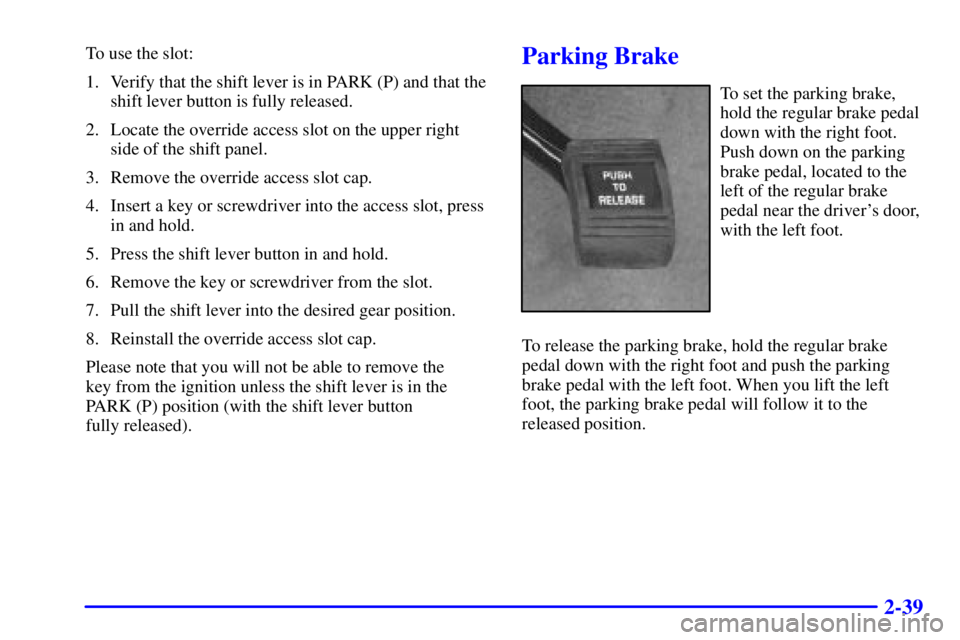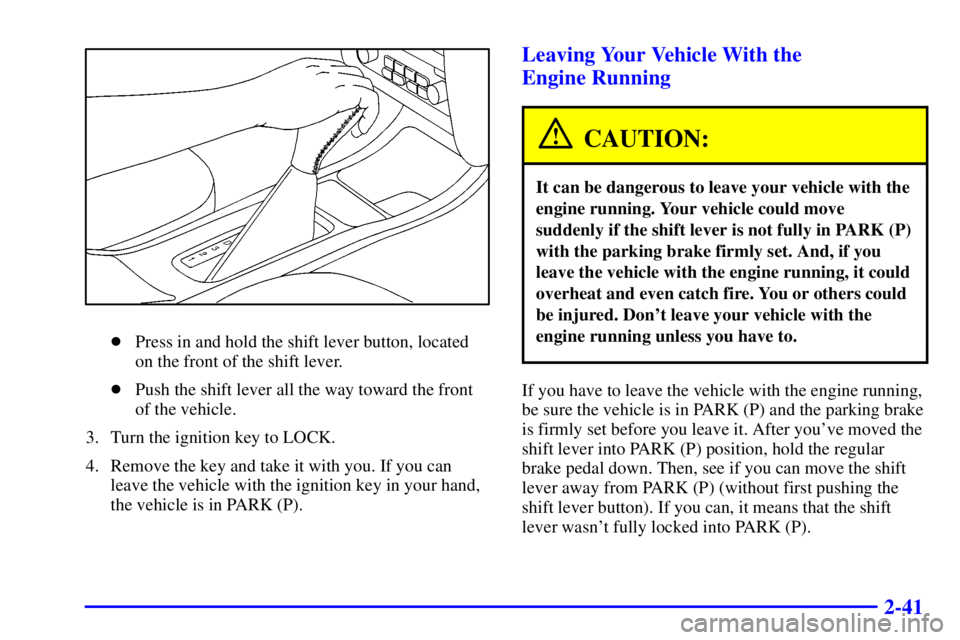Page 107 of 376

2-39
To use the slot:
1. Verify that the shift lever is in PARK (P) and that the
shift lever button is fully released.
2. Locate the override access slot on the upper right
side of the shift panel.
3. Remove the override access slot cap.
4. Insert a key or screwdriver into the access slot, press
in and hold.
5. Press the shift lever button in and hold.
6. Remove the key or screwdriver from the slot.
7. Pull the shift lever into the desired gear position.
8. Reinstall the override access slot cap.
Please note that you will not be able to remove the
key from the ignition unless the shift lever is in the
PARK (P) position (with the shift lever button
fully released).Parking Brake
To set the parking brake,
hold the regular brake pedal
down with the right foot.
Push down on the parking
brake pedal, located to the
left of the regular brake
pedal near the driver's door,
with the left foot.
To release the parking brake, hold the regular brake
pedal down with the right foot and push the parking
brake pedal with the left foot. When you lift the left
foot, the parking brake pedal will follow it to the
released position.
Page 109 of 376

2-41
�Press in and hold the shift lever button, located
on the front of the shift lever.
�Push the shift lever all the way toward the front
of the vehicle.
3. Turn the ignition key to LOCK.
4. Remove the key and take it with you. If you can
leave the vehicle with the ignition key in your hand,
the vehicle is in PARK (P).
Leaving Your Vehicle With the
Engine Running
CAUTION:
It can be dangerous to leave your vehicle with the
engine running. Your vehicle could move
suddenly if the shift lever is not fully in PARK (P)
with the parking brake firmly set. And, if you
leave the vehicle with the engine running, it could
overheat and even catch fire. You or others could
be injured. Don't leave your vehicle with the
engine running unless you have to.
If you have to leave the vehicle with the engine running,
be sure the vehicle is in PARK (P) and the parking brake
is firmly set before you leave it. After you've moved the
shift lever into PARK (P) position, hold the regular
brake pedal down. Then, see if you can move the shift
lever away from PARK (P) (without first pushing the
shift lever button). If you can, it means that the shift
lever wasn't fully locked into PARK (P).
Page 110 of 376

2-42 Torque Lock
If you are parking on a hill and you don't shift your
transaxle into PARK (P) properly, the weight of the
vehicle may put too much force on the parking pawl in
the transaxle. You may find it difficult to pull the shift
lever out of PARK (P). This is called ªtorque lock.º To
prevent torque lock, set the parking brake and then shift
into PARK (P) properly before you leave the driver's
seat. To find out how, see ªShifting Into PARK (P)º in
the Index.
When you are ready to drive, move the shift lever out of
PARK (P) before you release the parking brake.
If torque lock does occur, you may need to have another
vehicle push yours a little uphill to take some of the
pressure from the parking pawl in the transaxle, so you
can pull the shift lever out of PARK (P).
Shifting Out of PARK (P)
Your vehicle has an automatic transaxle shift lock
control system. You must fully apply your regular
brakes before you can shift from PARK (P) when the
ignition is in RUN. See ªAutomatic Transaxle
Operationº in the Index.
If you cannot shift out of PARK (P), ease pressure on
the shift lever by pushing it all the way into PARK (P)
while keeping the brake pedal pushed down. Release the
shift lever button. Then move the shift lever out of
PARK (P), being sure to press the shift lever button.
Page 113 of 376
2-45
CAUTION:
It can be dangerous to get out of your vehicle if
the shift lever is not fully in PARK (P) with the
parking brake firmly set. Your vehicle can roll.
Don't leave your vehicle when the engine is
running unless you have to. If you've left the
engine running, the vehicle can move suddenly.
You or others could be injured. To be sure your
vehicle won't move, even when you're on fairly
level ground, always set your parking brake and
move the shift lever to PARK (P).
Follow the proper steps to be sure your vehicle won't
move. See ªShifting Into PARK (P)º in the Index.
If you are parking on a hill and if you're pulling a
trailer, also see ªTowing a Trailerº in the Index.
Power Windows
Switches on the driver's door armrest operate each of
the windows when the ignition or retained accessory
power (RAP) is active. See ªRetained Accessory Power
(RAP)º in the Index. In addition, each passenger door
has its own window switch.
Page 119 of 376

2-51
Increasing Speed While Using Cruise Control
There are two ways to go to a higher speed:
�Use the accelerator pedal to get to the higher speed.
Push in the SET button, then release the button
and the accelerator pedal. You'll now cruise at the
higher speed.
�Move the cruise switch from ON to R/A. Hold it
there until you get up to the speed you want, and
then release the switch. To increase your speed in
very small amounts, move the switch to R/A briefly
and then release it. Each time you do this, your
vehicle will go 1 mph (1.6 km/h) faster.
The accelerate feature will only work after you set the
cruise control speed by pushing the SET button.
Reducing Speed While Using Cruise Control
There are two ways to reduce your speed while using
cruise control:
�Push in the SET button until you reach the lower
speed you want, then release it.
�To slow down in very small amounts, push the SET
button briefly. Each time you do this, you'll go
1 mph (1.6 km/h) slower.Passing Another Vehicle While Using Cruise Control
Use the accelerator pedal to increase your speed. When
you take your foot off the pedal, the vehicle will slow
down to the cruise control speed you set earlier.
Using Cruise Control on Hills
How well the cruise control will work on hills depends
upon your speed, load and the steepness of the hills.
When going up steep hills, you may have to step on the
accelerator pedal to maintain your speed. When going
downhill, you may have to brake or shift to a lower gear
to keep your speed down. Of course, applying the brake
takes you out of cruise control. Many drivers find this to
be too much trouble and don't use cruise control on
steep hills.
Ending Cruise Control
There are two ways to turn off the cruise control:
�Step lightly on the brake pedal, or
�move the cruise switch to OFF.
Erasing Cruise Speed Memory
When you turn off the cruise control or the ignition, or
shift into PARK (P) or NEUTRAL (N), the cruise
control set speed memory is erased.
Page 120 of 376
2-52
Exterior LampsThe lamp controls are located on the lower left side of
the instrument panel, to the left of the steering wheel.
They control these systems:
�Headlamps
�Taillamps
�Parking Lamps
�License Lamps
�Sidemarker Lamps
�Instrument Panel Lights
�Courtesy Lamps
�Fog Lamps
: Turn the knob to this symbol to turn on the
headlamps and other operating lamps.
: Turn the knob to this symbol to turn on the parking
and other operating lamps without the headlamps.
Turn the knob to OFF to turn off the lamps.
A warning chime will sound if you open the driver's
door when you turn the ignition switch to LOCK or
ACC with the lamps on.
Page 121 of 376

2-53 Daytime Running Lamps / Automatic
Headlamp Control
Daytime Running Lamps (DRL) can make it easier for
others to see the front of your vehicle during the day.
DRL can be helpful in many different driving
conditions, but they can be especially helpful in the
short periods after dawn and before sunset.
A light sensor on top of the instrument panel makes the
DRL work, so be sure it isn't covered.
The DRL system will make your low
-beam headlamps
come on at a reduced brightness when:
�The ignition is on,
�the headlamp switch is off,
�the transaxle is not in PARK (P) and
�the parking brake is released.When the DRL are on, only your low
-beam headlamps,
at a reduced brightness, will be on. The taillamps,
sidemarker and other lamps won't be on. Your
instrument panel won't be lit up either.
When it's dark enough outside, your headlamps will
change to full brightness. The other lamps that come on
with your headlamps will also come on.
When it's bright enough outside, the regular lamps will
go out, and your low
-beam headlamps change to the
reduced brightness of DRL.
To idle your vehicle with the DRL off, set the parking
brake while the ignition is in OFF or LOCK. Then start
your vehicle. The DRL will stay off until you shift out
of PARK (P) and release the parking brake.
As with any vehicle, you should turn on the regular
headlamp system when you need it.
Page 123 of 376

2-55 Courtesy Lamps
When any door is opened, several lamps come on.
These lamps are courtesy lamps. They make it easy for
you to enter and leave the vehicle at night. You can also
turn these lamps on by turning the interior lamps
thumbwheel completely to the right.
Illuminated Entry
The illuminated entry feature will light the interior of
the vehicle so that you can see the inside of the vehicle
before you enter at night. The interior lamps will come
on for 40 seconds when you unlock the doors using the
remote keyless entry transmitter (if equipped) and the
ignition is in LOCK or OFF. After 40 seconds have
elapsed, the interior lamps will slowly fade out.
The lamps will fade out before 40 seconds have
elapsed if you:
�Lock all doors using the remote keyless entry
transmitter (if equipped).
�Lock the doors using the power door lock switch.When any door is opened, illuminated entry is canceled.
The interior lamps will stay on while any door is opened
and slowly fade out when all doors are closed. The
interior lamps may stay on for up to 25 seconds after all
doors have been closed if they have not been locked.
See ªDelayed Illuminationº later in this section.
Delayed Illumination
The delayed illumination feature will continue to light
the interior of the vehicle for 25 seconds after all the
doors have been closed so that you can find the ignition
and buckle the seat belt at night. Delayed illumination
will not occur while the ignition is in RUN or
ACCESSORY. After 25 seconds have elapsed, the
interior lamps will slowly fade out. The lamps will fade
out before the 25 seconds have elapsed if you:
�Turn the ignition to RUN or ACCESSORY.
�Lock all doors using the remote keyless entry
transmitter (if equipped).
�Lock the doors using the power door lock switch.
To turn delayed illumination feature off or on, see
ªLocks and Lighting Choicesº in the Index.